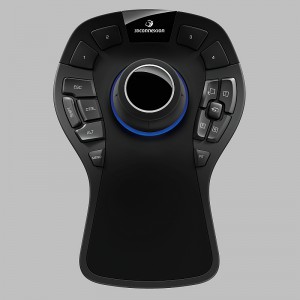Nach dem „großen“ Modell SpacePilot Pro hat 3DConnexion auf der Euromold ein eher reduziertes Eingabegerät vorgestellt: Die Space Mouse Pro greift das Layout der ersten SpaceMäuse auf, die noch in „Computerbeige“ und Grau gehalten waren und oberhalb der 3D-Kappe eine Leiste mit Buttons hatten.

Gleichzeitig erinnern Form und Layout sehr an den SpaceExplorer. Im Großen und Ganzen scheint die Evolution der äußeren Form abgeschlossen – Handballenauflage, Kappe, mehr oder weniger Buttons seitlich und oberhalb angeordnet.
Die SpaceMouse Pro hat deren vier oberhalb der Kappe, und diese sind je nach Applikation mit unterschiedlichen Funktionen belegt.Diese frei belegbaren Knöpfe waren allerdings schon immer die Crux der SpaceGeräte – wie auch aller anderen Zusatzgeräte – denn deren Belegung muss man sich zunächst einmal merken. Bei den SpacePiloten ging man den Weg, ein Display einzubauen, das die Tastenbelegung anzeigte – ergonomisch gesehen keine gute Lösung, denn sie bedingt, dass man zum Nachsehen der Tastenbelegung den Blick vom Schirm nehmen muss.
Antonio Pascucci, Vice President Products bei 3Dconnexion, zeigte mir, wie 3DConnexion diesen Nachteil angegangen ist. Drückt man eine der vier Tasten länger, erscheint ein kleines Menü auf dem Bildschirm, das die Belegung der Tasten und auch die derzeitig gedrückte Taste anzeigt. Sehr clever gelöst, denn so kann man mit Maus und SpaceMouse am CAD-Modell arbeiten, ohne den Blick vom Schirm zu nehmen.
Nur zu einer Gelegenheit ist noch der Blick zur Tastatur nötig: Zum Eingeben von Maßen. Auch für diese Eingabe hat 3DConnexion eine Lösung gefunden: Eine virtuelle Tastatur ähnlich einem Taschenrechner, die sich per Tastendruck einblenden lässt. Neben den vier „Top-Knöpfen“ bietet die SpaceMouse Pro ähnlich dem SpacePilot oder dem SpaceExplorer die fünf Knöpfe rechts für das Anwählen von Front-, Seiten- und Draufsicht. Links finden sich weitere Buttons, die mit ESC, CTRL, ALT und Shift belegt sind, also auch bei z.B. Shift-Mausklicks eine tastaturlose Bedienung ermöglichen.
After the „big“ model SpacePilot Pro, 3DConnexion presented at the Euromold a rather reduced input device: The Space Mouse Pro uses the layout on the first SpaceMice who were in „computer beige“ and gray and had a row of Buttons above the 3D cap . Shape and layout are also very reminiscent of the space explorer. By and large, the evolution of the outer form seems to be completed – palm rest, cap, and around that more or less buttons.
The Space Mouse Pro has four of them above the cap, which have different functions depending on the application. Those assignable buttons have always been the crux of the SpaceEquipment – as well as all other input devices – because You have to remember the assignment first. In the SpacePilots the solution was to incorporate a display that indicated the key assignments – ergonomically seen no good solution, because it implies that you had to take away the focus of vision from the screen to see the information.
Antonio Pascucci, vice president of products at 3DConnexion, showed me how this disadvantage is addressed. By pressing one of four keys longer, a little menu appears on the screen that shows the configuration of the keys and also the currently pressed key. Very cleverly solved, because you can work with mouse and Space oMousen the CAD model without taking eyes off the screen.
Only one opportunity to look for the keyboard is still necessary: To enter dimensions. Even for this, 3DConnexion has found a solution: a virtual keyboard similar to a calculator, provides by a keystroke. In addition to the four „top buttons“, the SpaceMouse Pro like the SpacePilot and the SpacePilot features five buttons on the right for selecting the front, side and top view. To the left buttons are assigned with ESC, CTRL, ALT and Shift, so even e.g. Shift-clicks are a keyless operation now.
